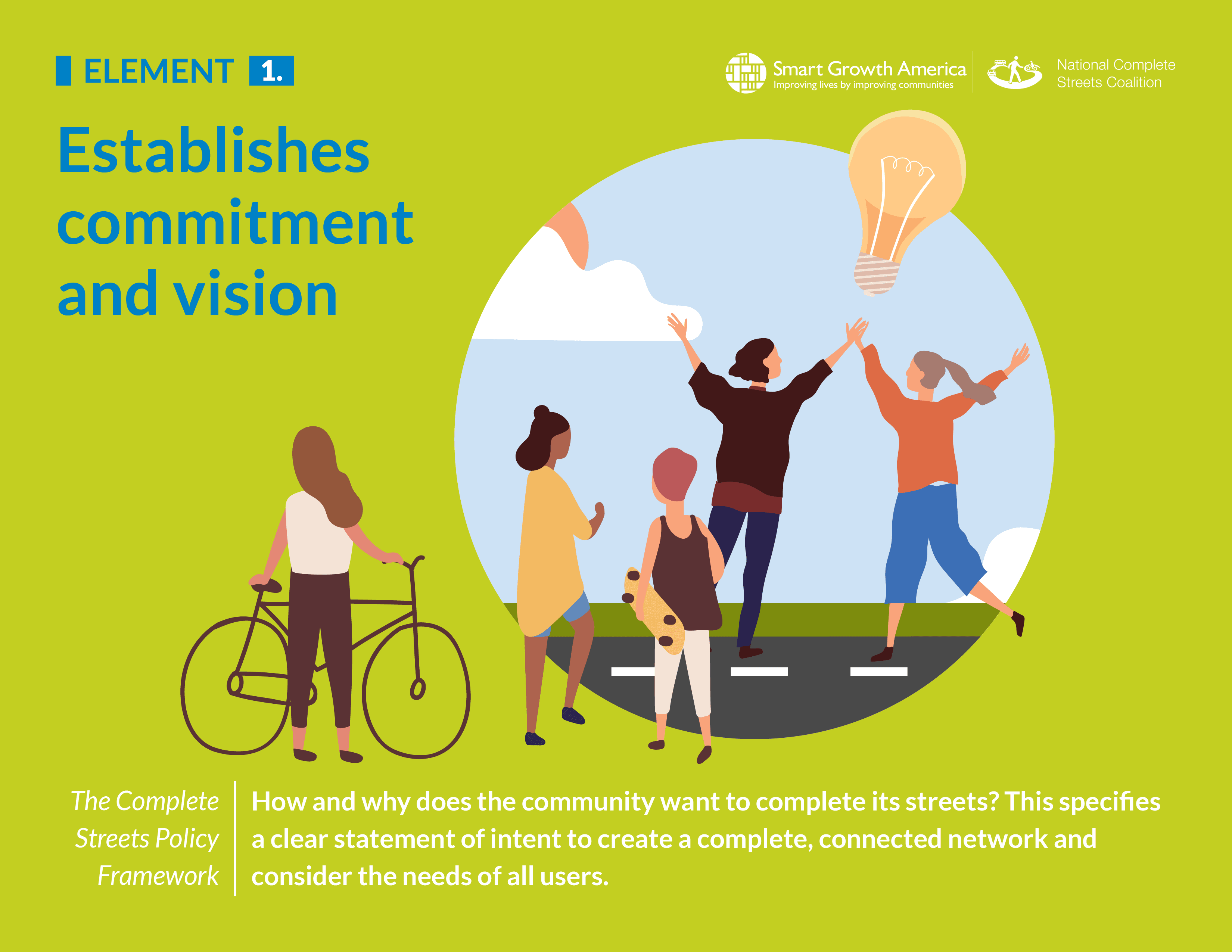
News
By Steve Davis, April 24, 2023
How and why does a community want to complete its streets? Clear answers to that question—an unmistakable and binding statement of intent—are the vital first element for creating a complete, connected network of streets that considers the needs of all users.

Every policy is an opportunity for a jurisdiction to make its intentions and motivations clear to the public as they craft, develop, and prioritize their rationale for adopting a Complete Streets policy. No two communities are identical, and no two Complete Streets policies should be exactly the same either.
Why is this element integral to a strong Complete Streets policy?
Every successful effort to do something markedly different—whether that’s a new approach to street design or designing a longer-lasting light bulb—starts with the “why” and the “how.” Starting a policy with a clear statement of intent and commitment to Complete Streets accomplishes several vital purposes: It makes the intentions crystal clear to a public who can provide accountability on execution. It shapes or directs the community’s approach to its transportation practices, policies, and decision-making processes. And it provides a necessary foundation for the rest of the policy.
What does this element look like in practice?
In practical terms, a commitment and vision means that the policy uses clear, binding, and enforceable language like “shall” or “must” in the legislative text itself, rather than words like “may” or “considers.”
In the earliest years of this movement, a large share of the Complete Streets policies adopted across the country were non-binding resolutions. This was not good enough for a community that truly wanted to build Complete Streets. Policies that are binding and not just “optional” are proven to make a tangible difference in what gets built, how, and where.
The policy must clearly acknowledge the need for building a complete, connected, comprehensive transportation network and explicitly state the tangible benefits of ensuring all people can comfortably travel to and from their destinations safely, in a reasonable amount of time, without breaking the bank.
Most notably, and improving upon the standards that policies were held to a decade ago, equity—which includes the consideration of race, income, and physical ability—should be a core motivation for pursuing a Complete Streets policy.
The policies that receive the maximum point value from this area also mention several transportation modes and specifically call out biking and walking. Why those modes specifically? Because a Complete Streets policy is both about prioritizing the most vulnerable users of the transportation system (people walking, rolling, and biking), and fostering a paradigm shift away from prioritizing speedy car travel, the status quo of transportation planning for the last 60-plus years.
Complete Streets policies also work best when the policy reflects a community’s own unique vision and needs. While each policy calls for a commitment to diverse users and abilities, communities should also articulate their own particular visions of economic, equitable, sustainable, healthy, safe, and livable futures. The process of writing and adopting a Complete Streets policy provides a valuable opportunity for the community to come together and articulate their deeply held values and a shared vision, building a foundation of support to advocate for the longer-term changes that a strong policy requires. By setting out a clear vision and committing to realizing it, communities can create better policies that reach their most pressing, unique needs—and their most vulnerable populations.
Policy scoring details
In our framework for evaluating and scoring Complete Streets policies, this element is worth a total of 12 out of 100 possible points. This element is the third most valuable of the 10 in part because it both provides a foundation for the other elements and establishes the clear and binding commitment by the jurisdiction to institutionalize a Complete Streets approach. Without binding language, the other elements lose their potential value.
- 3 points: The policy is clear in intent, stating firmly the jurisdiction’s commitment to a Complete Streets approach, using “shall” or “must” language. This needs to be in the body of the legislation, not the “whereas” statement.
- (1 point) – The policy states the jurisdiction “may” or “considers” Complete Streets in their transportation planning and decision-making processes.
- (0 points) – The policy language is indirect with regard to their intent to apply a Complete Streets approach, using language such as “consider Complete Streets principles or elements.”
- 2 points: mentions the need to create a complete, connected, network.
- (0 points) No mention.
- 2 points: specifies at least one motivation or benefit of pursuing Complete Streets.
- (0 points) No mention.
- 1 point: specifies equity as an additional motivation or benefit of pursuing Complete Streets.
- (0 points) No mention.
- 4 points: specifies modes, with a base of four modes, two of which must be biking and walking.
- (0 points) Policy mentions fewer than four modes and/or omits biking or walking.
Related News

© 2025 Smart Growth America. All rights reserved
Site By3Lane Marketing


























